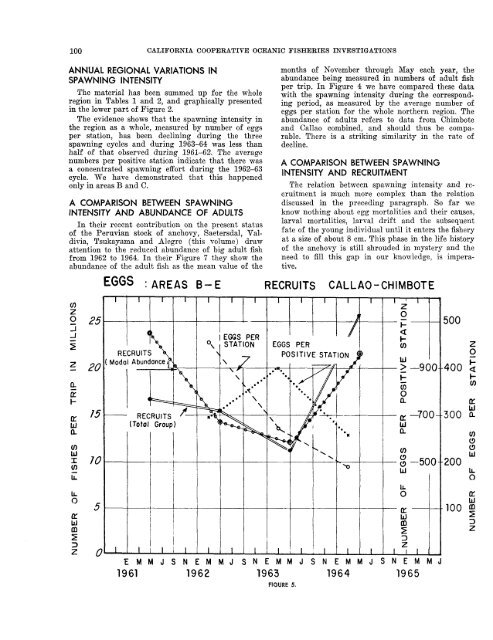CalCOFI Reports, Vol. 11, 1967 - California Cooperative Oceanic ...
CalCOFI Reports, Vol. 11, 1967 - California Cooperative Oceanic ...
CalCOFI Reports, Vol. 11, 1967 - California Cooperative Oceanic ...
Create successful ePaper yourself
Turn your PDF publications into a flip-book with our unique Google optimized e-Paper software.
100 CALIFORNIA COOPERATIVE OCEANIC FISHERIES INVESTIGATIONSANNUAL REGIONAL VARIATIONS INSPAWNING INTENSITYThe material has been summed up for the wholeregion in Tables 1 and 2, and graphically presentedin the lower part of Figure 2.The evidence shows that the spawning intensity inthe region as a whole, measured by number of eggsper station, has been declining during the threespawning cycles and during 1963-64 was less thanhalf of that observed during 1961-62. The averagenumbers per positive station indicate that there wasa concentrated spawning effort during the 1962-63cycle. We have demonstrated that this happenedonly in areas B and C.A COMPARISON BETWEEN SPAWNINGINTENSITY AND ABUNDANCE OF ADULTSIn their recent contribution on the present statusof the Peruvian stock of anchovy, Saetersdal, Valdivia,Tsukayama and Alegre (this volume) drawattention to the reduced abundance of big adult fishfrom 1962 to 1964. In their Figure 7 they show theabundance of the adult fish as &e mean value of themonths of November through May each year, theabundance being measured in numbers of adult fishper trip. In Figure 4 we have compared these datawith the spawning intensity during the correspondingperiod, as measured by the average number ofeggs per station for the whole northern region. Theabundance of adults refers to data from Chimboteand Callao combined, and should thus be comparable.There is a striking similarity in the rate ofdecline.A COMPARISON BETWEEN SPAWNINGINTENSITY AND RECRUITMENTThe relation between spawning intensity and recruitmentis much more complex than the relationdiscussed in the preceding paragraph. So far weknow nothing about egg mortalities and their causes,larval mortalities, larval drift and the subsequentfate of the young individual until it enters the fisheryat a size of about 8 cm. This phase in the life historyof the anchovy is still shrouded in mystery and theneed to fill this gap in our knowledge, is imperative.EGGS : AREAS B-E RECRUITS CALLAO-CHIMBOTEhI-v)- w > -900 II- -(I)00-- -700-wav)(3-- a -500wiLLO I500z0 -400 5I-v)U300 k!200cn0(3wLL0UW100 g3ZE M M J S N E M M J S N E M M J S N E M M J S N E M M J1961 1962 1963 1964 1965FIGURE 5.















